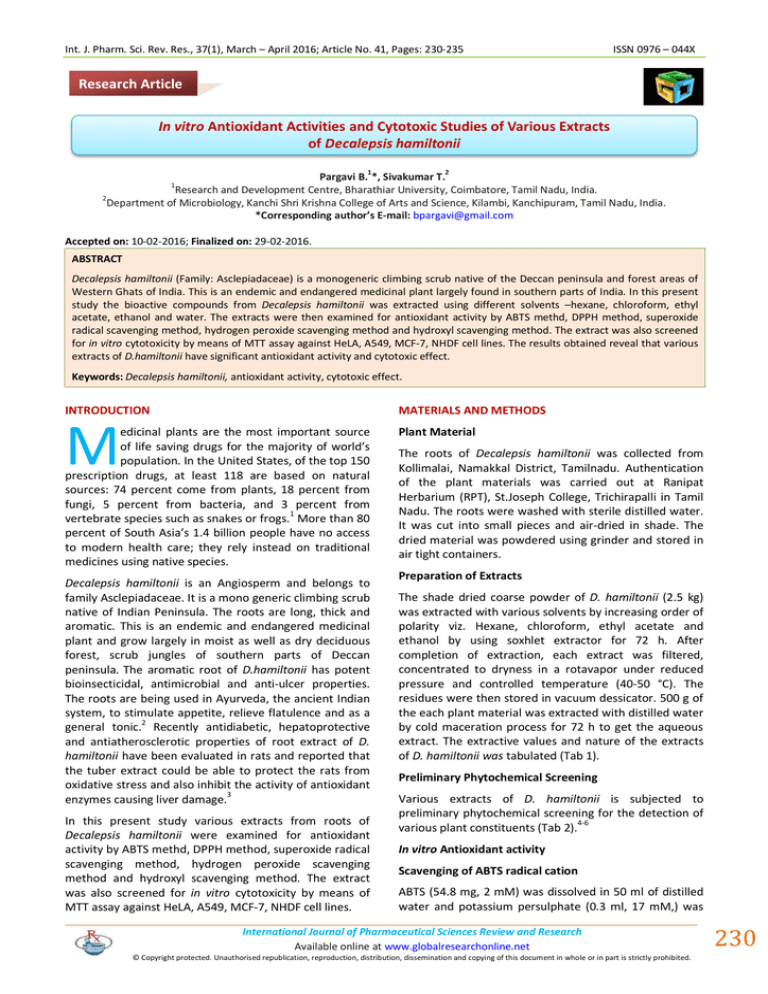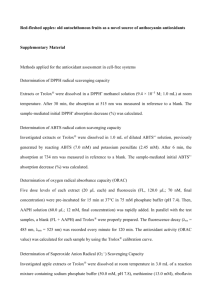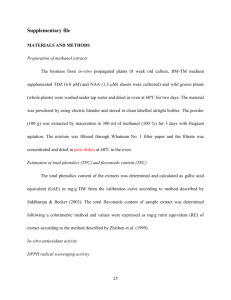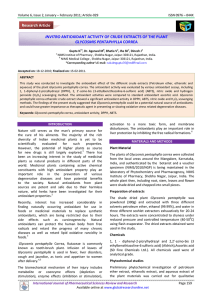Document 13310909
advertisement

Int. J. Pharm. Sci. Rev. Res., 37(1), March – April 2016; Article No. 41, Pages: 230-235 ISSN 0976 – 044X Research Article In vitro Antioxidant Activities and Cytotoxic Studies of Various Extracts of Decalepsis hamiltonii 1 2 Pargavi B. *, Sivakumar T. Research and Development Centre, Bharathiar University, Coimbatore, Tamil Nadu, India. 2 Department of Microbiology, Kanchi Shri Krishna College of Arts and Science, Kilambi, Kanchipuram, Tamil Nadu, India. *Corresponding author’s E-mail: bpargavi@gmail.com 1 Accepted on: 10-02-2016; Finalized on: 29-02-2016. ABSTRACT Decalepsis hamiltonii (Family: Asclepiadaceae) is a monogeneric climbing scrub native of the Deccan peninsula and forest areas of Western Ghats of India. This is an endemic and endangered medicinal plant largely found in southern parts of India. In this present study the bioactive compounds from Decalepsis hamiltonii was extracted using different solvents –hexane, chloroform, ethyl acetate, ethanol and water. The extracts were then examined for antioxidant activity by ABTS methd, DPPH method, superoxide radical scavenging method, hydrogen peroxide scavenging method and hydroxyl scavenging method. The extract was also screened for in vitro cytotoxicity by means of MTT assay against HeLA, A549, MCF-7, NHDF cell lines. The results obtained reveal that various extracts of D.hamiltonii have significant antioxidant activity and cytotoxic effect. Keywords: Decalepsis hamiltonii, antioxidant activity, cytotoxic effect. INTRODUCTION MATERIALS AND METHODS M edicinal plants are the most important source of life saving drugs for the majority of world’s population. In the United States, of the top 150 prescription drugs, at least 118 are based on natural sources: 74 percent come from plants, 18 percent from fungi, 5 percent from bacteria, and 3 percent from vertebrate species such as snakes or frogs.1 More than 80 percent of South Asia’s 1.4 billion people have no access to modern health care; they rely instead on traditional medicines using native species. Decalepsis hamiltonii is an Angiosperm and belongs to family Asclepiadaceae. It is a mono generic climbing scrub native of Indian Peninsula. The roots are long, thick and aromatic. This is an endemic and endangered medicinal plant and grow largely in moist as well as dry deciduous forest, scrub jungles of southern parts of Deccan peninsula. The aromatic root of D.hamiltonii has potent bioinsecticidal, antimicrobial and anti-ulcer properties. The roots are being used in Ayurveda, the ancient Indian system, to stimulate appetite, relieve flatulence and as a general tonic.2 Recently antidiabetic, hepatoprotective and antiatherosclerotic properties of root extract of D. hamiltonii have been evaluated in rats and reported that the tuber extract could be able to protect the rats from oxidative stress and also inhibit the activity of antioxidant 3 enzymes causing liver damage. In this present study various extracts from roots of Decalepsis hamiltonii were examined for antioxidant activity by ABTS methd, DPPH method, superoxide radical scavenging method, hydrogen peroxide scavenging method and hydroxyl scavenging method. The extract was also screened for in vitro cytotoxicity by means of MTT assay against HeLA, A549, MCF-7, NHDF cell lines. Plant Material The roots of Decalepsis hamiltonii was collected from Kollimalai, Namakkal District, Tamilnadu. Authentication of the plant materials was carried out at Ranipat Herbarium (RPT), St.Joseph College, Trichirapalli in Tamil Nadu. The roots were washed with sterile distilled water. It was cut into small pieces and air-dried in shade. The dried material was powdered using grinder and stored in air tight containers. Preparation of Extracts The shade dried coarse powder of D. hamiltonii (2.5 kg) was extracted with various solvents by increasing order of polarity viz. Hexane, chloroform, ethyl acetate and ethanol by using soxhlet extractor for 72 h. After completion of extraction, each extract was filtered, concentrated to dryness in a rotavapor under reduced pressure and controlled temperature (40-50 °C). The residues were then stored in vacuum dessicator. 500 g of the each plant material was extracted with distilled water by cold maceration process for 72 h to get the aqueous extract. The extractive values and nature of the extracts of D. hamiltonii was tabulated (Tab 1). Preliminary Phytochemical Screening Various extracts of D. hamiltonii is subjected to preliminary phytochemical screening for the detection of 4-6 various plant constituents (Tab 2). In vitro Antioxidant activity Scavenging of ABTS radical cation ABTS (54.8 mg, 2 mM) was dissolved in 50 ml of distilled water and potassium persulphate (0.3 ml, 17 mM,) was International Journal of Pharmaceutical Sciences Review and Research Available online at www.globalresearchonline.net © Copyright protected. Unauthorised republication, reproduction, distribution, dissemination and copying of this document in whole or in part is strictly prohibited. 230 Int. J. Pharm. Sci. Rev. Res., 37(1), March – April 2016; Article No. 41, Pages: 230-235 ISSN 0976 – 044X added. The reaction mixture was left to stand at room temperature overnight in dark before usage. To 0.2 ml of various concentrations of the extracts/standards added 1.0 ml of freshly distilled DMSO and 0.16 ml of ABTS solution to make a final volume of 1.36 ml. After 20 min, absorbance was measured spectrophotometrically at 734 nm.7-8 solution in PBS. After 10 min, the absorbance was measured at 230 nm.9 DPPH Assay Materials DPPH assay is based on the measurement of the scavenging ability of antioxidant towards the stable DPPH radical. The assay was carried out in a 96 well microtitre plate. To 200 l of DPPH solution, 10 l of each of the extract or standard solution was added separately in wells of the microtitre plate. The plates were incubated at 37oC for 30 min and the absorbance of each solution was 9 measured at 490 nm using ELISA reader. RPMI-1640 media, penicillin-G, streptomycin, amphotericin-B, EDTA, trypan blue, SDS lysis buffer and MTT (3-(4,5-dimethylthiazol-2yl)-2,5-diphenyltetrazolium bromide) were procured from Himedia, Mumbai, India. Fetal bovine serum was obtained from Gibco’s, USA, Trypsin (Trypsin-EDTA [1x] in HBSS) from Gibco’s UK and Dimethyl sulphoxide (DMSO) from Merck India Ltd, Mumbai, India. Scavenging of hydroxyl radical Additional equipments used p-NDA method CO2 incubator (WTC Binder, Germany), Laminar air flow cabin (Klenzaids, Chennai, India), Refrigerated centrifuge (Biofuge Fresco, by Heraeus, Germany), ELISA-reader (for MTP) (Anthos 2010, Germany) Deep freezer (Polar Angelantoni Industries, Italy), Ultrasonic bath (Transonic [460/H], by Elma, Germany), Vaccum pump (Zenith [model: PDF-2-2.5], Mumbai, India), Pipettes (Eppendorf, Hamburg, Germany), Culture plates (Felcon, Germany), Centrifuge tubes (Felcon, Germany), Eppendorf tubes (Tarsons, Mumbai, India), Aerosol resistant tips (Tarsons, Mumbai, India), Flat-bottomed 96-well MTP, tissue culture grade (Tarsons, Mumbai, India). To a reaction mixture containing ferric chloride (0.5 ml, 0.1 mM), EDTA (0.5 ml, 0.1 mM), ascorbic acid (0.1 mM, 0.5 ml), hydrogen peroxide (2 mM, 0.5 ml) and p–NDA (0.01 mM, 0.5 ml) in phosphate buffer (pH 7.4, 20 mM), added various concentrations of extract or standard (0.5 ml) to give a final volume of 3 ml. Sample blank was prepared by adding 0.5 ml sample and 2.5 ml of phosphate buffer. Absorbances of these solutions were measured at 440 nm.10 Scavenging of hydroxyl radical by deoxyribose method To the reaction mixture containing deoxyribose (0.2 ml, 3 mM), ferric chloride (0.2 ml, 0.1 mM), EDTA (0.2 ml, 0.1 mM), ascorbic acid (0.2 ml, 0.1 mM) and hydrogen peroxide (0.2 ml, 2 mM) in phosphate buffer (pH, 7.4, 20 mM), added 0.2 ml of various concentrations of extract or standard in freshly distilled DMSO to give a total volume of 1.2 ml. The solutions were then incubated for 30 min at 37 °C. After incubation, ice–cold trichloro acetic acid (0.2 ml, 15% w/v) and thiobarbituric acid (0.2 ml, 1% w/v), in 0.25 N HCl were added. The reaction mixture was kept in a boiling water bath for 30 min, cooled and the 11 absorbance was measured at 532 nm. Scavenging of superoxide radical by alkaline DMSO method To the reaction mixture containing 1 ml of alkaline DMSO (1 ml DMSO containing 5 mM NaOH in 0.1 ml water) and 0.3 ml of the extract in freshly distilled DMSO at various concentrations, added 0.1 ml of NBT (1 mg/ml) to give a final volume of 1.4 ml. The absorbance was measured at 9 560 nm. Scavenging of hydrogen peroxide A solution of hydrogen peroxide (20 mM) was prepared in phosphate buffered saline (PBS, pH 7.4). Various concentrations of 1 ml of the extract or standard in methanol were added to 2 ml of hydrogen peroxide In vitro Cytotoxicity Studies Antiproliferative Activity of Extracts by MTT [(3-(4,5dimethylthiazol-2yl)-2,5-diphenyltetrazoliumbromide] Assay Cell lines Human Cervical Cancer cells (HeLA), Human Lung Cancer cells (A549), Human Breast Cancer cells (MCF-7) and Normal Human Dermal Fibroblasts (NHDF) were obtained from National Centre of Cell Sciences (Pune, India). Procedure 0.1 ml of the cell suspension (containing 1x105cells) and 0.1 ml of the plant extracts (15.625-1000 g/ml) in DMSO such that the final concentration of DMSO in media is less than 1%) were added to the 96 well plates and kept in carbondioxide incubator with 5% CO2, at 37 °C for 72 hours. Blank contains only cell suspension and control wells contain 1 % DMSO and cell suspension. After 72 hours, 20 l of MTT was added and kept in carbon dioxide incubator for 2 hours followed by 80l of lysis buffer (15%SLS in 1:1 DMF and water). The plate was covered with aluminum foil to protect it from light. Then the 96 well plates are kept in rotary shaker for 8 hours. After 8 hours, the 96 well plates were processed on ELISA reader for absorption at 562nm. The readings were averaged and viability of the test samples was compared with DMSO control.12 The percentage growth inhibition was calculated using the following formula International Journal of Pharmaceutical Sciences Review and Research Available online at www.globalresearchonline.net © Copyright protected. Unauthorised republication, reproduction, distribution, dissemination and copying of this document in whole or in part is strictly prohibited. 231 Int. J. Pharm. Sci. Rev. Res., 37(1), March – April 2016; Article No. 41, Pages: 230-235 % ℎ ℎ = 100 − × 100 RESULTS AND DISCUSSION The percentage yield of various extracts was calculated (Tab 1). Maximum yield of 10.6% was obtained using ethanol followed by water. Preliminary phytochemical screening of extracts shows the presence of carbohydrates, glycosides, alkaloids, terpenoids, phytosterols, flavanoids, phenolics and tannins (Tab 2). In the last two decades there has been an explosive interest in the role of oxygen free radicals, more generally known as “reactive oxygen species”(ROS) and of reactive nitrogen species’(RNS) in experimental and clinical medicine14. ROS/RNS are known to play a dual role in biological systems, since they can be either harmful or beneficial to living system.13 The antioxidant activity of various extracts of D. hamiltonii was investigated against various in vitro models. Since free radicals are of different chemical entities, it is also essential to test the extract against many free radicals to prove their antioxidant activity. Hence, a large number of in vitro methods were used for the screening. IC 50 values obtained were compared with the standards used, that is, Ascorbic acid and Quercetin. ABTS radical scavenging activity is relatively recent one, which involves a more drastic radical, chemically produced and is often used for screening complex antioxidants mixtures such as plant extracts, beverages and biological fluids. In the present study, all the prepared extracts, except hexane, showed radical scavenging activity against ABTS radical. Ethanol and ethyl acetate showed potent activity against ABTS radical scavenging. The order of activity was as follows: Ethyl acetate>Ethanol>Water>Chloroform>Hexane. The results were displayed in table 3. The DPPH is a stable free radical which has been accepted as a tool for estimating free radical scavenging activities of antioxidants14. Ethanol and ethyl acetate showed potent activity against DPPH radical scavenging method. The order of activity was as follows: Ethyl acetate>Ethanol>Water>Chloroform>Hexane. The results were displayed in table 3. Presence of flavonoids and phenolic compounds in the extracts are possibly involved in their antiradical activity. ISSN 0976 – 044X 15 biomolecules . In the present study the Hydroxyl radical scavenging activity of various extracts was assessed by pNDA method and deoxyribose degradation method. In this method the plant extracts showed potent Hydroxyl radical scavenging activity and is compared with standards used (table 4.). The scavenging activity may be due to the presence of various phytochemicals including polyphenols and flavonoids in the extracts. Superoxide radical is known to be a very harmful species to cellular components as a precursor of more reactive species11. Based on the IC50 values, Ethyl acetate and Ethanol showed potent activity against Superoxide radical. The order of activity was as follows: Ethyl acetate>Ethanol>Water>Chloroform>Hexane. The results were displayed in table 5. Hydrogen peroxide itself is not very reactive but sometimes is toxic to cell because it may give rise to hydroxyl radical in the cells16. Therefore removing of hydrogen peroxide is very important for antioxidant defense in cell system. The phenolic and flavonoidal compounds of the extract may probably be involved in scavenging hydrogen peroxide. In conclusion, the results obtained from various free radicals scavenging systems reveal that various extracts of D.hamiltonii have significant antioxidant activity. The extracts are found to have different levels of antioxidant activity in all the methods tested. IC50 values obtained were comparable with that of the standards used, that is, ascorbic acid and Quercetin. Since, free radicals are of different chemical entities, it is essential to test the extracts against many free radicals to prove their antioxidant activity. In vitro cytotoxicity studies were performed to evaluate the anticancer efficacy of various solvent extracts of Decalepsis hamiltonii against various human cancer cell lines and normal cell line. The results revealed that all the extracts possess cytotoxic effect with a wide range of activity. Among the tested extracts, the ethanol extract showed lowest IC50 value against all the tested cancer cell lines. The inhibitory concentration of the extracts to kill 50% of the normal cell line was found to be three to four folds high which indicate the selective toxicity of the extracts towards the cancer cells and they are safe on normal cells. The results obtained were displayed in Table 6. Among the oxygen radicals, Hydroxyl radical is the most reactive and induces severe damage to adjacent Table 1: Colour, Nature and Extractive Values of various Extracts of Decalepsis hamiltonii. Name of the extract Parameters observed Colour Nature Yield (%) Hexane Dark green Solid mass 1.7 Chloroform Green Solid mass 2.6 Ethyl acetate Greenish Yellow Solid mass 2.4 Ethanol Brown Semi-solid mass 10.6 Water Brown Dried powder 9.4 International Journal of Pharmaceutical Sciences Review and Research Available online at www.globalresearchonline.net © Copyright protected. Unauthorised republication, reproduction, distribution, dissemination and copying of this document in whole or in part is strictly prohibited. 232 Int. J. Pharm. Sci. Rev. Res., 37(1), March – April 2016; Article No. 41, Pages: 230-235 ISSN 0976 – 044X Table 2: Preliminary Phytochemical Analysis of various extracts of Decalepsis hamiltonii. Name of the extract Name of the Phyto-chemical Hexane Chloroform Ethyl acetate Ethanol water Carbohydrates - - - + + Glycosides - - + + + Alkaloids - + - + - Terpenoids + - - + - Phytosterols + - - + - Flavonoids - - + + + Phenolics - - - + + Tannins - - - + + Saponins - - - + + Proteins & amino acids - - - + + Fixed oils & fats + + - - - Gums & mucilages - - - - - Table 3: ABTS and DPPH Radical Scavenging Activities of Various Extracts of Decalepsis hamiltonii. IC50 (µg/ml)* by method Extracts/Standards ABTS DPPH Hexane >1000 >1000 Chloroform 102.4 ± 3.28 153.2 ± 10.7 Ethyl acetate 12.34 ± 0.26 21.1 ± 0.79 Ethanol 37.41 ± 1.23 52.7 ± 1.86 Water 84.2 ± 2.61 91.2 ± 2.32 Ascorbic Acid 13.21 ± 0.49 5.21 ± 0.45 Quercetin 1.22 ± 0.04 6.21 ± 0.63 *Average of three determinations, three replicates; Data were expressed as Mean ± SEM. Table 4: Hydroxyl Radical Scavenging Activities of Various Extracts of Decalepsis hamiltonii. IC50 (µg/ml)* by method Extracts/Standards Hydroxyl radical scavenging assay P-NDA method Deoxyribose method Hexane >1000 >1000 Chloroform 389.1 ± 12.47 403.3 ± 14.6 Ethyl acetate 174.13 ± 7.43 222.4 ± 14.6 Ethanol 242.3 ± 11.3 267.2 ± 6.91 Water 256.6 ± 14.2 372.2 ± 12.3 Ascorbic Acid >1000 - Quercetin >1000 27.4 ± 1.72 *Average of three determinations, three replicates; Data were expressed as Mean ± SEM. International Journal of Pharmaceutical Sciences Review and Research Available online at www.globalresearchonline.net © Copyright protected. Unauthorised republication, reproduction, distribution, dissemination and copying of this document in whole or in part is strictly prohibited. 233 Int. J. Pharm. Sci. Rev. Res., 37(1), March – April 2016; Article No. 41, Pages: 230-235 ISSN 0976 – 044X Table 5: Superoxide and Hydrogen peroxide Radical Scavenging Activities of Various Extracts of Decalepsis hamiltonii. Extracts/Standards IC50 (µg/ml)* by method Superoxide radical scavenging H2O2 radical scavenging Hexane >1000 >1000 Chloroform 396.1 ± 14.2 276.8 ± 12.4 Ethyl acetate 198.6 ± 10.2 112.8 ± 2.42 Ethanol 267.37 ± 8.78 129.1 ± 6.82 Water 298.4 ± 11.9 214.3 ± 13.8 Ascorbic Acid >1000 167.4 ± 3.42 Quercetin >1000 21.53 ± 1.32 *Average of three determinations, three replicates; Data were expressed as Mean ± SEM. Table 6: In vitro cytotoxic activity of various extracts of Decalepsis hamiltonii. Name of the Extract IC50 Value (µg/ml)* A549 HeLa MCF-7 NHDF Hexane 658.3 517.9 413.8 964.8 Chloroform 222.7 199.3 228.5 630.7 Ethyl acetate 207.9 169.5 139.2 856.8 Ethanol 134.9 117.3 119.7 948.4 Water 246.7 228.1 188.7 658.5 *Average of three determinations, three replicates; IC50, Drug concentration that produce 50% cell death following 72 h of drug exposure. Figure 1: In vitro cytotoxic activity of various extracts against different cell lines. International Journal of Pharmaceutical Sciences Review and Research Available online at www.globalresearchonline.net © Copyright protected. Unauthorised republication, reproduction, distribution, dissemination and copying of this document in whole or in part is strictly prohibited. 234 Int. J. Pharm. Sci. Rev. Res., 37(1), March – April 2016; Article No. 41, Pages: 230-235 CONCLUSION The results of our study reveal that the extracts of D.hamiltonii exhibit potent antioxidant activity and also cytotoxicity against human cell lines. Chemical constituents reported in phytochemical screening may be responsible for these activities of the extracts against cell lines. Further isolation and identification of the active compounds as lead in the crude extracts is recommended for the drug development. REFERENCES 1. Ecological Society of America. 1997. Ecosystem Services: Benefits Supplied to Human Societies by Natural Ecosystems. Issues in Ecology 2. Washington, DC: Ecological Society of America. 2. Vedavathy S. Decalepsis hamiltonii Wight & Arn. – An endangered source of indigenous health Drink. Nat. Prod. radiance, 3, 2004, 22-23. 3. Naveen S and Khanum F. Antidiabetic, antiatheroscrerotic and hepatoprotective properties of Decalepsis hamiltonii in streptozotocin induced diabetic rats. J. Food Biochem, 34, 2010, 1231-1248. 4. Wagner H, Bladt S and Zgainski EM, Plant Drug Analysis, Springer – Verlag, Berlin, 1984, 298-334. 5. Kokate CK, Practical Pharmacognosy 4th Edition, Vallabh Prakashan, Delhi, 1994, 107-111. 6. Harborne JB. Methods of plant analysis. In Phytochemical Methods, Chapman and Hall, London, 1973, 1-32. 7. Nenadis N, Wang L, Tsimidou M and Zhang H. Estimation of scavenging activity of phenolic compounds using the ABTS assay. J. Agri. Food Chem, 52, 2004, 4669–4674. ISSN 0976 – 044X 8. Re R, Pellegrini M, Proteggente A, Pannala A, Yang M and Rice EC. Antioxidant activity applying an improved ABTS radical cation decolorisation assay. Free Radic Biol Med, 26, 1999, 1231–1237. 9. Jayaprakasha GK, Jaganmohan Rao L and Sakariah KK. Antioxidant activities of flavidin in different in vitro model systems. Bioorg Med Chem, 12, 2004, 5141–5146. 10. Elizabeth K, Rao MNA. Oxygen radical scavenging activity of curcumin. Intl J Pharm, 58, 1990, 237. 11. Halliwell B, Gutteridge JMC. Free radicals in biology and medicine, 4th Edition, Oxford University Press, Oxford, UK, 2007. 12. Senthil Kumar R, Rajkapoor B, Perumal P. Antitumor and Cytotoxic Activities of Methanol Extract of Indigofera linnaei Ali against Transplantable Tumors and Human Cancer Cell Lines. Asian Pacific Journal of Cancer Prevention, 12(3), 2011, 613-618. 13. Valko M, Izakovic M, Mazur M, Rhodes CJ and Tesler J. Role of oxygen radicals in DNA damage and cancer incidence. Molecular and Cellular Biochemistry, 266, 2004, 37-56. 14. Sancehz-Moreno C. Review: Methods used to evaluate the free radical scavenging activity in foods and biological systems. Food Science and Technology International, 8, 2002, 121-137. 15. Sakanaka S, Tachibana Y and Okada Y. Preparation and antioxidant properties of extracts of Japanese Persimmon leaf tea (Ka-Kiniha-Cha). Food Chemistry, 89, 2005, 569575. 16. Halliwell B. Reactive oxygen species in living systems: Source, Biochemistry and role in human diseases. American Journal of Medicine, 91, 1991, 14-22. Source of Support: Nil, Conflict of Interest: None. International Journal of Pharmaceutical Sciences Review and Research Available online at www.globalresearchonline.net © Copyright protected. Unauthorised republication, reproduction, distribution, dissemination and copying of this document in whole or in part is strictly prohibited. 235






